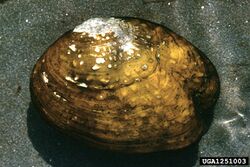Biology:Theliderma sparsa
| Theliderma sparsa | |
|---|---|

| |
| Scientific classification | |
| Domain: | Eukaryota |
| Kingdom: | Animalia |
| Phylum: | Mollusca |
| Class: | Bivalvia |
| Order: | Unionida |
| Family: | Unionidae |
| Genus: | Theliderma |
| Species: | T. sparsa
|
| Binomial name | |
| Theliderma sparsa (Lea, 1841)
| |
| Synonyms[3] | |
| |
Theliderma sparsa, the Appalachian monkey-face pearly mussel or Appalachian monkeyface, is a species of freshwater mussel, an aquatic bivalve mollusk in the family Unionidae, the river mussels.
This species is endemic to western Virginia and eastern Tennessee in the Appalachia region, in the Southeastern United States.
It is critically endangered[1] due to pollution of the rivers in which it lives.[citation needed] Being a detritivore, the mussel absorbs the pollutants which contaminate the river as it feeds.
Distribution
There are two to three populations remaining. In the Clinch River of Virginia there is a small, isolated population. A population in the upper Powell River in Tennessee is nearly gone. These occurrences may not be viable. All other occurrences have been extirpated.[4]
Reproduction
Like other unionid mussels, Theliderma sparsa uses fish as an intermediate host for its glonchidia larvae. Captive breeding experiments have demonstrated that the mussel larvae can develop on the gills of blotched chub (Erimystax insignis) and streamline chub (Erimystax dissimilis).[5] Water temperature and vibration prompt release of glonchidia, according to Virginia Department of Wildlife Resources Southwest Virginia Mussel Recovery Coordinator Tim Lane.[5]
Conservation
Theliderma sparsa is a federally endangered species.[6] It gained protection under the Endangered Species Act with this status in 1976.[7]
References
- ↑ 1.0 1.1 Bogan, A.E. (1996). "Theliderma sparsa". IUCN Red List of Threatened Species 1996: e.T19042A8792941. doi:10.2305/IUCN.UK.1996.RLTS.T19042A8792941.en. https://www.iucnredlist.org/species/19042/8792941. Retrieved 18 November 2021.
- ↑ "Appendices | CITES". https://cites.org/eng/app/appendices.php.
- ↑ "Theliderma sparsa (I.Lea, 1841)". Species. GBIF. http://www.gbif.org/species/5782385.
- ↑ NatureServe (3 March 2023). "Theliderma sparsa". Arlington, Virginia: NatureServe. https://explorer.natureserve.org/Taxon/ELEMENT_GLOBAL.2.120629/Theliderma_sparsa.
- ↑ 5.0 5.1 Kirk, Molly (15 September 2022). "Solving the Appalachian Monkeyface Mussel Mystery". Virginia Department of Wildlife Resources. https://dwr.virginia.gov/blog/solving-the-appalachian-monkeyface-mussel-mystery.
- ↑ "Appalachian monkeyface (pearlymussel) (Theliderma sparsa)". U.S. Fish & Wildlife Service. https://ecos.fws.gov/ecp/species/7154.
- ↑ 41 FR 24062
Wikidata ☰ {{{from}}} entry
 |


